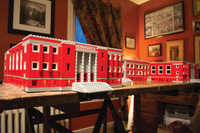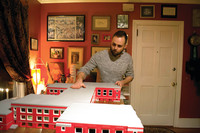It was a combination of chance and inspiration that led Andrew Grover to build scaled-down LEGO models of the closed Aldrich and Gorton Junior High Schools.
The plastic pieces of architectural art …
This item is available in full to subscribers.
We have recently launched a new and improved website. To continue reading, you will need to either log into your subscriber account, or purchase a new subscription.
If you are a current print subscriber, you can set up a free website account by clicking here.
Otherwise, click here to view your options for subscribing.
Please log in to continue |
|


It was a combination of chance and inspiration that led Andrew Grover to build scaled-down LEGO models of the closed Aldrich and Gorton Junior High Schools.
The plastic pieces of architectural art will be on display for viewing at the Warwick Public Library on Saturday, Feb. 10.
“It’s funny how things come together,” he said. “It just happened that a few years back, I came in possession of all the Legos from when I was a kid. The timing of it was interesting, and it wasn’t like I had this instantaneous thought, but I got it in my head at some point that I love these buildings so much…So somewhere in my head it all came together: ‘Build them out of LEGOs!’”
Grover, a Wrentham High School physics teacher of 16 years, has always kept a hobby in art and a passion for the architecture of early Rhode Island Public Schools. After the closures of Gorton and the Aldrich almost three years ago due to a major school consolidation plan, Grover said he was concerned over the fate of the buildings.
“No doubt about it that the city of Warwick needed to close down schools. I have no blame against the process going on,” he said, “but in all of these discussions of what buildings should be kept open as schools and what not, the cultural value, aesthetics, and history of buildings never came up.”
Grover felt the need to show his support.
“I decided to champion these because they don’t have a lot of people championing them. I’ve always liked the old schools in particular, and I want to be the advocate for these,” he said. “We should breathe life back into them, forcing our culture to change the way we do things. I feel like we need to break this cycle where we build, let it fall apart, and rebuild."
Grover started the building process over a year ago, when he began taking pictures of the outside Aldrich around Christmastime. He recalled having to take multiple shots of each angle in order to get the dimensions correct. He also credits Google Earth for helping him along the way.
Grover said because Aldrich was his first LEGO model, it was a learning experience for him.
“You’re not a good judge of how many LEGOs you have,” he said. “I thought I had enough LEGOs to build five of these buildings, but it turned out I had enough for the first floor and half.”
As a result, Grover had to dip into his savings in order to fund the first project. Both projects came out to about $1000 dollars apiece and involved thousands of LEGOs. Each project took a few months of working sporadically in his free time.
Grover explained that he wanted to use mostly basic bricks, but some pieces, like the doors of Aldrich, had to be specially ordered and shipped from other countries.
After Grover completed Aldrich, he had developed a basis on how to begin building Gorton.
“That one [Aldrich] I had to use my own money, but it was worth it because it convinced the Rhode Island State Council on the Arts that I had a good project here,” he said. Grover received a grant for $800 dollars from RISCA to begin building Gorton.
Grover’s enthusiasm for school architecture around the state was evident. He elaborated on the art-deco style of Gorton that he tried to emulate in his model, as well as the neo-classical architecture of Aldrich with the Greek pillars across the front.
“There’s so much to look at in these buildings. The aesthetics are there.”
He believed LEGOs were the most appropriate medium to get his point across.
“I could paint a beautiful picture of the school, I just don’t think it would get the attention…These buildings have to be enjoyed in this capacity,” he said.
In both models, he wired lights throughout each of the floors. He took it a step further with Gorton, even designing the inside of the auditorium with seats and a stage, as well as basketball hoop in the gymnasium. Philip Thornton, the Superintendent of Warwick Schools, had given him a tour of Gorton when Grover had reached out to him about the project, allowing him to get a look at the inside of the building.
Grover referenced the Newport Mansions and the East Side of Providence, places that have been deemed as culturally relevant to Rhode Island, and hopes people will start to look at these school buildings in the same way. He said that private schools such as Moses Brown and Lasalle take pride in their school structures, and there is no reason why public schools shouldn’t feel the same.
“We’re cued to see certain things as historic, cultural, and beautiful,” said Grover. “I chose these (Aldrich and Gorton) because this is where I live.
Grover understands that keeping these buildings alive would require a lot of taxpayer money, but said he is willing to pay out of his own pocket for the cause.
“While cost and size is relevant of course, I just want history and culture to be brought up in these conversations.”
He hopes that the buildings will never see the fate of a wrecking ball, and at the very least continue to be re-purposed.
Currently, Gorton is being used as the school district’s administrative offices, but Aldrich has yet to be occupied since closing.
Grover hopes to continue modeling more schools in the future, and mentioned Cranston East as a possibility. Grover was once a student there. He hopes to eventually work his way up to the Providence school district, which he said would take a lot more time and money, but also that the buildings are unbelievably beautiful.
Grover put his models of Aldrich and Gorton Junior High Schools on display at the Warwick Public Library on Jan. 27, and there will be a short presentation and reception held on Feb. 10 for them. He considers these buildings architectural monuments to our history and culture in Rhode Island, and wants to share that with the public.
“This is my way of saying to folks, ‘what do you think?’ Public officials can only get the resources that the people of the state of Rhode Island are willing to give them, and if this makes it easier to warm Rhode Islanders up to the idea, that’s great.”
Comments
No comments on this item Please log in to comment by clicking here